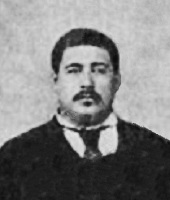Related Research Articles
In Hawaiian religion, Hiʻiaka is a daughter of Haumea and Kāne.

In Hawaiian mythology, Laka is the name of two different popular heroes from Polynesian mythology.. Lengthy legends of their exploits extend throughout the islands, and the kings of Tahiti and Hawaiʻi claimed them as their ancestors.
Kaha'i is a handsome Polynesian demigod whose exploits were popular in many Polynesian mythologies.
In Hawaiian mythology, Kalamainu'u was a lizard goddess.
In Māori mythology, Wahieroa is a son of Tāwhaki, and father of Rātā.

In Hawaiian religion, Pele is the goddess of volcanoes and fire and the creator of the Hawaiian Islands. Often referred to as "Madame Pele" or "Tūtū Pele" as a sign of respect, she is a well-known deity within Hawaiian mythology and is notable for her contemporary presence and cultural influence as an enduring figure from ancient Hawaii. Epithets of the goddess include Pele-honua-mea and Ka wahine ʻai honua.
Paʻao is a figure from Hawaii. He is most likely a Hawaiian historical character retold through Hawaiian legend. According to Hawaiian tradition and folklore, he is said to have been a high priest from Kahiki, specifically "Wewaʻu" and "ʻUpolu." In Hawaiian prose and chant, the term "Kahiki" is applied in reference to any land outside of Hawai'i, although the linguistic root is conclusively derived from Tahiti. "Wewaʻu" and "Upolu" point to actual places in the Society Islands, Samoa, and Hawaiian scholars and royal commentators consistently claim Paʻao came from Samoa; he was a Samoan priest with properties in both Tonga and Samoa. He arrived on the north shores of the Big Island and named it "Upolu" after Samoa main village.
In the mythology of the Tuamotu archipelago, Kiho-tumu represents the supreme god.
In the Polynesian narrative of the Tuamotus archipelago in the South Pacific, Puna is the king of Hiti-marama or of Vavaʻu, depending on the story.
In Hawaiian mythology, Laʻieikawai (Lāʻi.e.-i-ka-wai) and her twin sister Laʻielohelohe were princesses, and were born in Lāʻie, Oʻahu.
In Hawaiian mythology, Wahieloa is a hero associated with the Kaha'i and Laka epics.
In Tuamotu mythology, Vahieroa marries Matamata-taua or Tahiti-to'erau, and on the night of the birth of their son, the great Tuamotuan hero, Rata, the parents go fishing and are snatched away by the demon bird belonging to Puna, king of Hiti-marama, "an island north of Pitcairn and Elizabeth but long since swallowed in the sea."
In the Tuamotu Rata cycle, Tahiti-tokerau was a water-nymph whom Vahi-vero marries. She was abducted by Puna, king of the underworld and rescued by her husband. They then become parents of Rata.

In Māori mythology, Tiki is the first man created by either Tūmatauenga or Tāne. He found the first woman, Marikoriko, in a pond; she seduced him and he became the father of Hine-kau-ataata. By extension, a tiki is a large or small wooden, pounamu or stone carving in humanoid form, notably worn on the neck as a hei-tiki, although this is a somewhat archaic usage in the Māori language. Hei-tiki are often considered taonga, especially if they are older and have been passed down throughout multiple generations. Carvings similar to ngā tiki and coming to represent deified ancestors are found in most Polynesian cultures. They often serve to mark the boundaries of sacred or significant sites. As hei-tiki they were appropriated by Pākehā as symbols of good fortune, and commercialised; this is ironic, as tiki also means "unsuccessful".
In the Tuamotu islands, the telling of the full cycle of the legend of Rata takes several evenings to tell.
Rata, in Tahitian mythology, is said to have become king of Tahiti when his uncle, king Tumu-nui, and his father Vahieroa are swallowed by a great clam while they are on their way to Pitcairn. When he reaches adulthood, Rata plans to avenge his father. As in the Tuamotuan version, Rata identifies a tree to build his canoe, but it is protected by forest elves. After he captures them they build it for him in a single night. While en route for Pitcairn, Rata and his crew are sucked down into the same clam, but they use their spears to cut the monster open. They rescue the remains of Rata's father and uncle and bury them back in Tahiti. After recovering from their adventure, Rata sets out for further adventures. See also Aremata-Popoa and Aremata-Rorua.
In Tahitian mythology, Vahieroa is a son of Tafa'i and his wife Hina, and is born at his father's house in the Tapahi hills of Mahina in north Tahiti. He weds Maemae-a-rohi, sister of the ruling chief Tumu-nui.
Faumea is a figure in Polynesian mythology, specifically that of the Tuamotus archipelago of French Polynesia, where she is regarded as an "eel-woman". The sea god Tangaroa encounters her when he sails to her island. In addition to being an eel-woman, Faumea has eels within her vagina which eat men, reflecting the folk concept of vagina dentata. However, Faumea teaches Tangaroa how to lure the eels out and they have sex. Faumea bears Tangaroa two sons: Tu-Nui-Ka-Rere and Turi-A-Faumea.

Alexander Ariʻipaea Vehiaitipare Salmon Jr. (1855–1914) was the English-Jewish-Tahitian co-owner of the Maison Brander plantations on Tahiti and de facto ruler of Easter Island from 1878 till its cession to Chile in 1888.

ʻOro is a god in Tahiti and Society Islands mythology. The veneration of ʻOro, although practiced in varying intensity among the islands, was a major religion of the Society Islands in the 17th and 18th centuries, especially Tahiti, Tahaa, Moorea, and Raiatea. On Tahiti, ʻOro was the main deity and the god of war. The secret society of Arioi was closely linked because of its rites. On the Marquesas Islands, ʻOro bore the name Mahui.
References
- M. Beckwith, Hawaiian Mythology (University of Hawaii Press: Honolulu) 1970.
- R.D. Craig, Dictionary of Polynesian Mythology (Greenwood Press: New York, 1989), 317.
